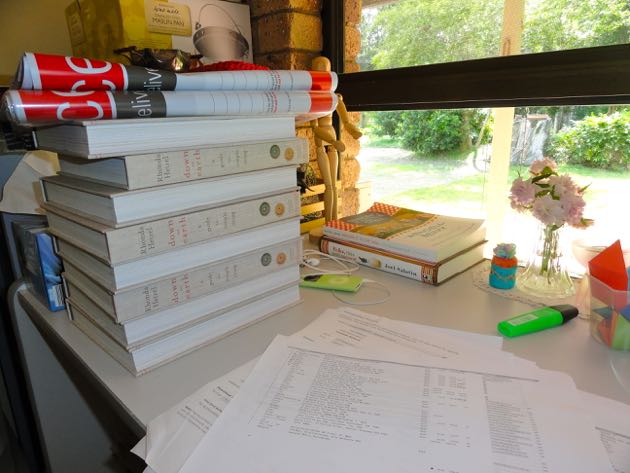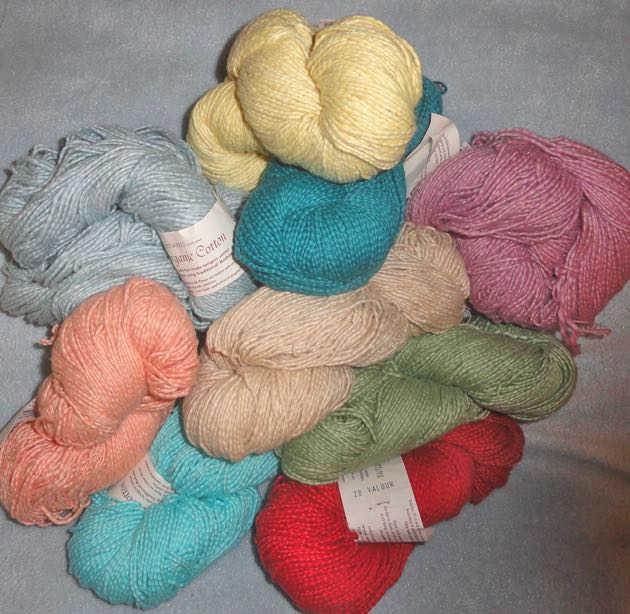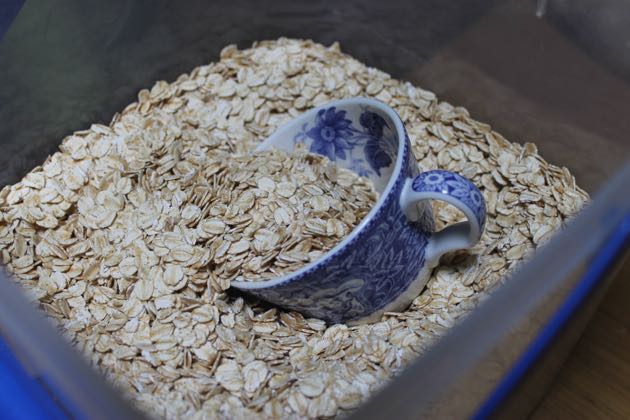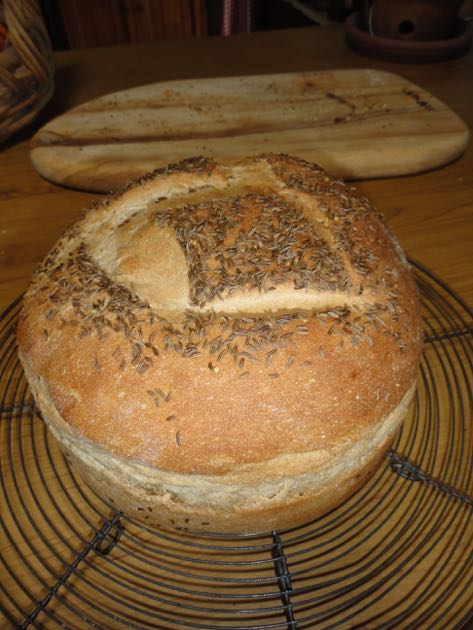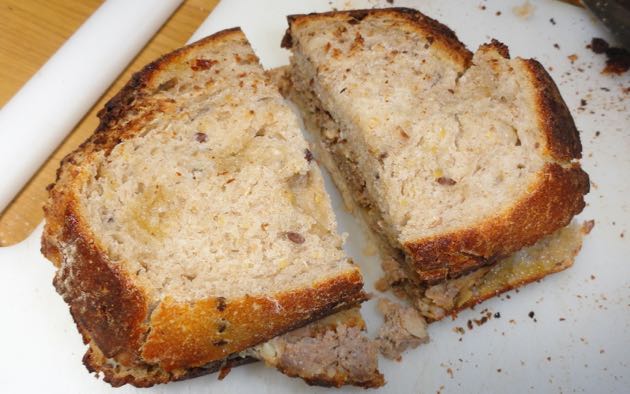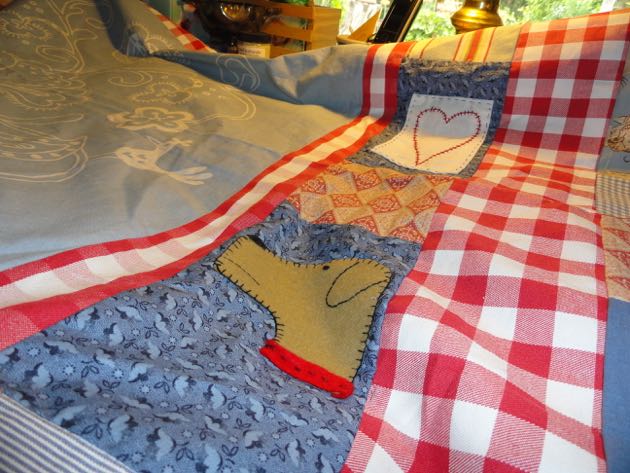Last week I wrote about soaking your rolled oats before you eat them and the benefits that come from that. Today I thought I'd continue on and talk about soaking other rye and wheat grains before they're eaten; today's post is about bread. The reasoning behind all this is that grains soaked before cooking are easier to digest than those that aren't, and if they're soaked in an acidic liquid such as whey, buttermilk, yoghurt, or water with lemon juice, the grain will release most of its goodness instead of a small portion of it. It's all got to do with humans having only one stomach so unsoaked grains pass through too fast to be broken down. That causes digestive problems for some people and the grains don't have enough time to release all their goodness, which affects all of us. Other grain-eating mammals such as cows, goats etc. have more than one stomach, or several compartments in their stomach, that allow them to process their food a lot longer than we do.

This bread is good on the first day and lasts to a second day but the crust and the bread itself aren't like a soft sandwich loaf. It's drier and the crust is crunchy.
It makes delicious toast and that's how we have it on the second day.
If you don't like that texture, try the rye mixed loaf below which is more like the texture of a sandwich loaf. Both are excellent as toast.
This is the half white-half rye loaf. It's the one I like the most because I think it has a better texture than the white loaf.
If you read about how to make bread in Nourishing Traditions it's a long process that I don't have the time nor the inclination for. I'm sure it produces very good bread but I'm a regular bread maker and need my bread to fit in with everything else I do in a day. I'm happy with the so called five minute bread, that I make up and allow to sit in the fridge for a few days. It's well and truly soaked by the time I bake my bread.
I found very similar recipe in my Maura Laverty classic Irish cook book, Full and Plenty, that I'm going to try this week. Her recipe for "yeast bread (overnight method)" was published in 1960. I'll share that recipe with you next week when I post about the bread I make.
The way I do the five minute bread is to make up the recipe in Artisan bread in five minutes a day, but with a tweak. You'll need a storage container capable of holding the mixture that will sit in the fridge for at least overnight, and for a few days after that. That takes care of the soaking. You can double the recipe quite easily if you have the room to store the dough and then you'll only make up one batch of dough for several loaves of bread.
The book says it makes four one pound loaves (that's just under two kilos).
- 3 cups warm water
- 1½ tablespoons yeast
- my tweak is to add 1 tablespoon of lemon juice to the water. OR you could use ½ cup of buttermilk, whey or yoghurt to the liquid before adding it to the mix, but you'll have to adjust the water content accordingly. Mix it thoroughly so it will be easier to incorporate it into the flour.
- 1½ tablespoons coarse salt
- 6½ cups unbleached white flour (or half rye and half white wheat flour)
I do this step in the morning, the day before I want the bread.
Before mixing them together, mix the top group together, then the second group together. Then add half the liquid to half the flour and mix together thoroughly. If you have a big mixer with a dough hook you can use that because it takes an effort to mix this. I do it in two batches and use a spatula. When the first batch is finished, tip it into your storage container and start the second batch. When both batches are in the container, mix them together with your hands, put a tea towel over the container and leave it on the bench to start rising.
After about two hours, take the tea towel off, put the lid on but don't press it down to make it air tight. The dough will let off gas and it needs to have some means of escape. I use a Decor long plastic bin and have the top attached at one end and sitting on the top other end. Put the dough in the fridge and store it there until you're ready to use it, but you can use it at any point after this first rise.
The dough after it's been removed from the fridge.

Don't knead the dough. It will develop the gluten and you don't want that. Just fold over the dough onto itself until it forms a smooth top.
When you want to bake a loaf, about two hours beforehand, take a piece of dough suitable for the size of your loaf from the container. Place it on a lightly floured board and fold the dough into itself so you have a smooth top and uneven bottom. You don't want to knead the dough, just bring it togehter as a nice smooth loaf. Let the dough sit to rise and return to room temperature. It won't rise a lot, it will do that more in the oven when it's baking.
Make sure the dough has flour over the top because that will protect it while it rests and rises.
About 20 minutes before you're ready to bake, preheat the oven to 450F/250C and place a cast iron pot with lid in the oven to heat up. After the dough has risen (about 45 minutes) carefully place the dough into the cast iron pot and with a very sharp knife, slash to top of the dough. Place the lid on the top of the pot. You could use a pizza stone to bake on, that is how they bake it in the artisan bread book.
Bake for 30 minutes, then remove the lid and bake until the top is golden brown.
Remove from the pot and place on a cake rack to cool.
The method below is the same recipe, using a cast iron pot, but with the addition of the dough being baked in a loaf pan inside the cast iron pot.
You can leave the dough in the fridge for up to a week if you want to. I think it makes better bread the longer it's in the fridge. I usually make a fresh loaf every second day and I get three fairly large loaves from one batch. If I had a large family or we ate more bread, I'd make up a double portion of the dough at a time. I have to say Maura's recipe looks easier so I'm looking forward to trying it. I have a sneaking suspicion I'll like it. ;- )
If you have trouble making bread it's probably because you don't knead the dough long enough or you under or over proof it. This method takes all that away and replaces it with time in the fridge. If you've never made a good loaf, try this and see how you go with it. Or, maybe you just want to wait for Maura's recipe. And I don't blame you at all for that.












